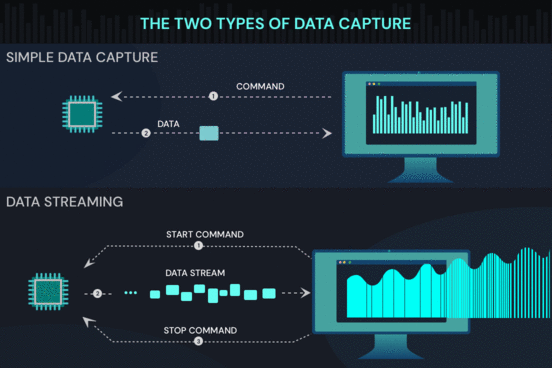In the life cycle of Integrated Circuits (ICs), Evaluation GUIs play a vital role in creating the market space for a chip. The requirement from an EVM GUI is to showcase the capabilities of the chip in an intuitive manner. Therefore, EVM GUIs essentially serve as data visualization tools, exhibiting the performance and characteristics of the chip.
Introduction to Data Capture and Visualization in Semi Evaluation Space
Live data visualization via EVM GUIs, lucidly articulates the performance and features of an IC. The GUI captures the live data from the IC in two ways:
1. Simple data capture – where a finite set of data is read and plotted on a graph either in a single shot or at regular intervals.
2. Datastream Capture – where the devices stream data infinitely without interruptions and are continuously captured by the GUI.

The Challenges in Seamless Data Capture
The modern controllers have a high throughput of >1000 MB/s and low latency of 0.1 µs, supporting mass data transfer. Capturing the data from the device at this speed is challenging and data streaming at this rate is precisely very demanding. In streaming systems, there is a likelihood that the application gets flooded with the incoming data, by the time the current raw data set is converted to meaningful information and plotted on the GUI, which may lead to loss of data. To catch up with the data streaming rates, the following two operations are done in parallel.
1. Procure the data from the device and store it in a temporary buffer/file storage and,
2. Retrieve that data from the buffer/file, parse it and plot it on the GUI.

The other bottleneck for data visualization is holding the processed data in memory. As we keep appending the graph with the incoming data, the memory soars and eventually crashes the application.
Solution
The GUI when run as a native application, has the advantage of being allocated the required memory (subjective to the Hardware limits). Whereas, web GUIs don’t have the memory management capacity like native applications. The web GUIs require flushing the data from the memory before it exceeds the limit. Thus, there is a need to improve the performance of web GUIs and it can be done by adopting modern concepts like Web Assembly.

With the modern solutions coming up, the web-based EVM GUIs continue to be good sources to captivate the market as they talk for your Integrated Circuits.
Written by
Nikitha Sairam
March 8, 2021